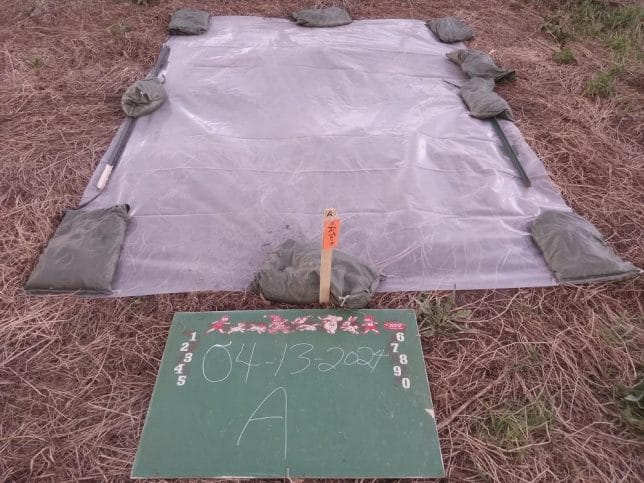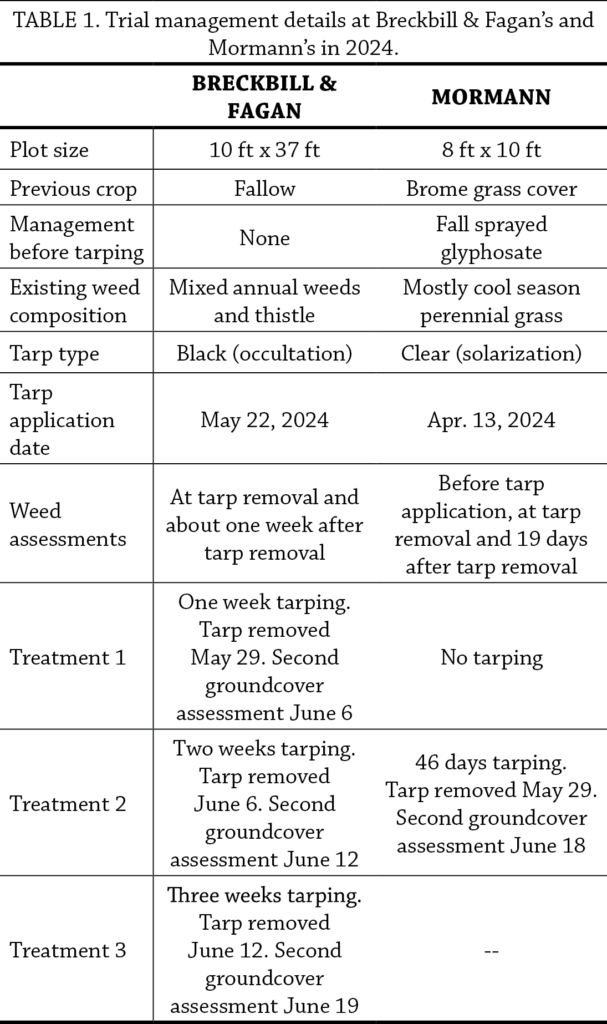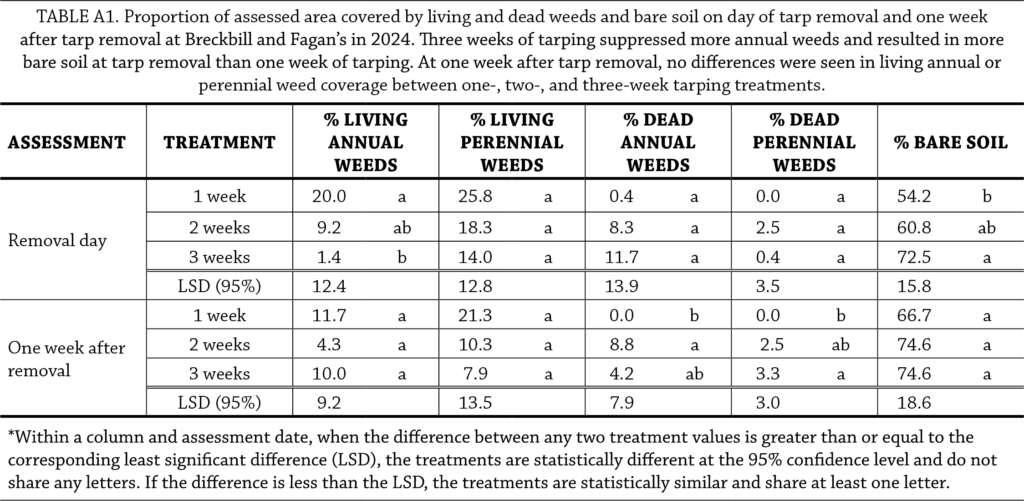This research was funded by NRCS and Ceres Trust.
In a Nutshell:
- Tarping is an increasingly common practice on vegetable farms for bed preparation and weed or cover crop termination. Farmers place either a black or a clear tarp on the ground for weeks to months to block light and/or heat the soil.
- Last year, Hannah Breckbill & Emily Fagan experimented with tarping with a black tarp to terminate a rye cover crop. This year, they focused their efforts on determining how long they should leave a black tarp on to terminate annual weeds from late May into June.
- Marlon Mormann is newer to tarping and conducted a trial comparing groundcover in plots where a clear tarp was used from mid-April through May and plots where no tarp was used.
Key Findings
- Breckbill & Fagan found that three weeks of tarping with black tarps significantly reduced the coverage of living annual weeds and resulted in more bare ground at tarp removal compared to one week of tarping.
- Mormann’s clear tarps successfully reduced the number of living perennial weeds compared to not tarping, but there were still some living perennial weeds after clear tarping for 46 days.
- Some weed regrowth was seen after all treatment lengths in the week after tarp removal (Breckbill & Fagan) and several weeks after clear tarp removal (Mormann).
Tarping is an increasingly common no-till method for preparing beds on vegetable farms. Farmers place clear or black plastic tarps on the bed, secure the edges with something heavy like sandbags or cinder blocks, and leave them out for at least a few weeks. Both types of tarp trap heat and moisture, allowing any seeds in the top layer of soil to germinate. With black “occultation” or light-blocking tarps, heat and lack of light for photosynthesis kills the weeds and any growing cover crops. With clear “solarization” tarps, direct sunlight heats the ground up enough to kill the plants and potentially sterilize ungerminated seeds. In addition to killing weeds and cover crops and creating a stale seed bed, tarping also preserves moisture and speeds up decomposition of organic matter, making it a very useful no-till practice [1].
Hannah Breckbill and Emily Fagan have been experimenting with black tarps for no-till management of their vegetable farm for several years. They have fully adopted tarping as their main bed prep practice as it reduces their in-season labor needs and replaces more physically intensive tillage and weeding. In a 2023 trial, they showed that occultation tarping with a black tarp could successfully terminate a rye cover crop in about three weeks when started in late May [2]. Even tarping for three and four weeks did not kill perennial thistles, though it did noticeably set them back. This year, Fagan hoped to figure out how long to leave a black tarp on to successfully kill annual weeds and prevent annual weed growth in the first week or so after tarp removal. “The results of this trial will help us fine-tune our weed management, which will help us save time and effort,” Fagan said.
Marlon Mormann was interested in using clear tarps to prepare ground for planting sweet corn but was skeptical that they would improve weed suppression. He is generally interested in no-till methods and reducing herbicide application to food crops. He decided to test the impact of clear tarps on weed regrowth in a field previously covered with a sod-like brome that was terminated with glyphosate in fall of 2023. In this trial, he assessed ground coverage before and after over a month of solarization tarping, from mid-April to late May, and compared it to a control treatment that was not tarped.
Methods
Design
Number of treatments and treatments varied between farms based on the farmer’s goals and are shown in Table 1. Each farmer established four randomized replicates of each treatment (Figure A1). Replication and treatment randomization allow for statistical analysis and conclusions about the effect of the treatments on yield.
Measurements
Breckbill & Fagan and Mormann chose three random locations in each replicate and estimated groundcover percent coverage of the following categories within ring of a known size (ex. hula hoop): living annual weeds, dead annual weeds, living perennial weeds, dead perennial weeds, and bare soil. Breckbill & Fagan performed these measurements on the day that tarps were removed and repeated them about one week after tarps were removed. Mormann performed these measurements at tarp application and at tarp removal, and qualitatively assessed weed regrowth with pictures 19 days after tarp removal and at sweet corn planting (Table 1).
Weather
To provide some additional context about solar heat inputs during this trial, we calculated the number of growing degree days (GDDs) accumulated during the tarping period and in the period between tarp removal and the second weed assessment. We used 32 °F as the base temperature. GDDs are calculated for each day that tarps were on the ground and then summed to get total GDD accumulation. The average daily air temperature is calculated for each day using NASA POWER modelled earth surface temperatures [3] then the base temperature (32 °F) is subtracted from the mean, resulting in the total GDDs accumulated that day. Days when the average daily air temperature is less than 32 °F are assumed to add 0 GDDs. We also note precipitation accumulation in the period between tarp removal and second weed assessment, sourced from the NASA POWER dataset.
Data analysis
To evaluate the effect of the tarping treatments on weed suppression, we used an analysis of variance (ANOVA) followed by Tukey’s Honest Significant Difference (HSD) at 95% confidence. If the difference between the two treatments was greater than the HSD, we considered this to be a statistically significant effect. 95% confidence means that 95 times out of 100, the differences we see between treatments would be due to true differences in the means rather than random chance. On the other hand, if the resulting difference between the two treatments was less than the HSD, we would consider the treatment results to be statistically similar. We could make these statistical calculations because the cooperators’ experimental design involved replication of the treatments (Figure A1).
Results and Discussion
Black occultation tarping – Breckbill & Fagan
At tarp removal, Breckbill & Fagan observed significantly fewer living annual weeds after three weeks of tarping (1%) compared to one week of tarping (20%). Bare soil also made up a higher proportion of groundcover after three weeks of tarping (73%) compared to one week (54%) (Figure 1; Table A1). The prevalence of bare soil indicates enhanced biomass decomposition and nutrient cycling after three weeds of tarping, which could allow for easier planting and better plant growth. While there were no statistically significant differences in annual weed coverage after one and two weeks of tarping or perennial weed coverage after any treatment length, living weed coverage generally trended lower with increased tarping treatment length (Table A1). Fagan noted that the spot they chose for the trial had fewer annual weeds generally than they expected, and that in retrospect she probably would have chosen a different spot to better answer their questions about annual weed suppression, specifically.
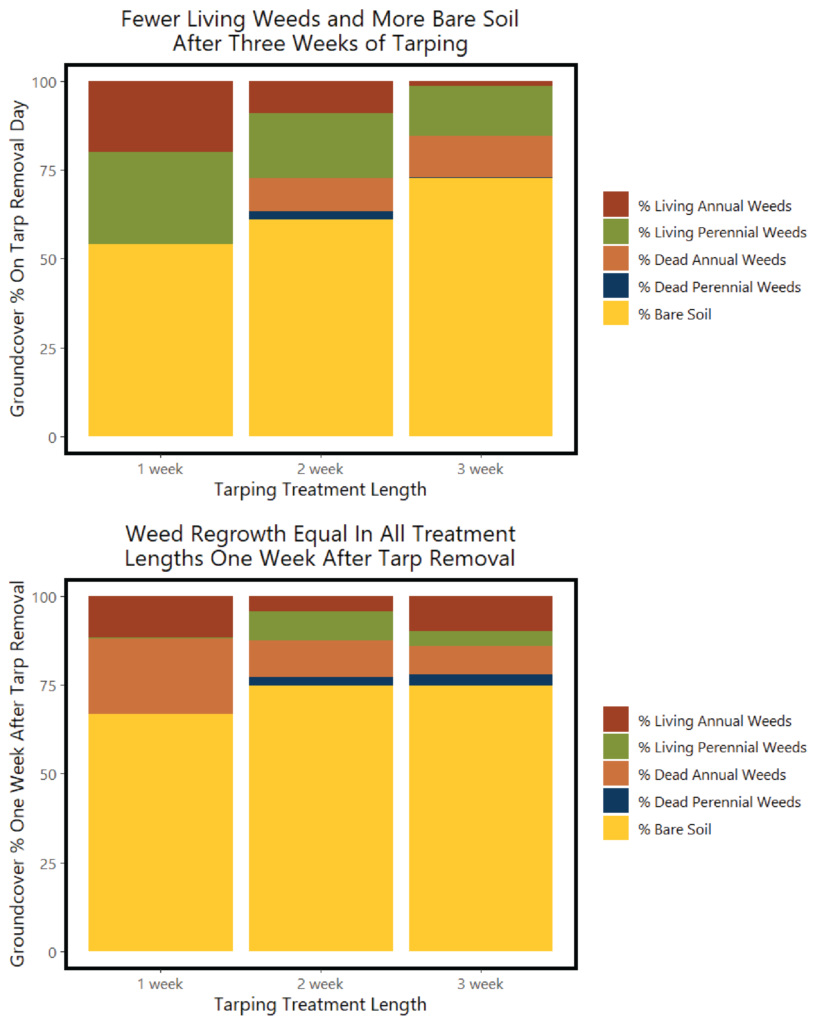
FIGURE 1. Ground coverage of living and dead annual and perennial weeds and bare ground on the day that tarps were removed (top) and about one week after tarps were removed (bottom) for each of the three tarping treatment lengths (one, two and three weeks) at Breckbill and Fagan’s.
In the week after tarp removal, there were no significant changes in dead or alive weed ground coverage within any of the individual tarping length treatments. Dead perennial weed coverage was slightly higher in the three-week tarping treatment (3%) compared to the one-week treatment (0%), and dead annual weed coverage was slightly higher in the two-week treatment (8%) compared to the one-week treatment (0%). However, Fagan noticed that one week after tarp removal in the three-week treatment, “There were some new annual weeds germinating, which surprised me – my hope would have been that they’d germinate under the tarp and then die.” The week after tarp removal in the 3-week treatment (June 12–19) accumulated 275 GDDs and 3.6 inches of rain, more than previous weeks, which likely contributed to increased annual weed germination (Table 2). Previous academic research has shown that tarping efficacy at creating a stale seed bed can vary from year-to-year, likely due to weather differences that affect the temperatures achieved under the tarp and soil moisture content during and immediately after tarping [4].
While Breckbill & Fagan’s previous research and experience has shown that tarping is not an effective solution for perennial thistle control, a large problem on their farm, three weeks of tarping did provide some perennial weed control. “The living perennial weeds were generally small thistles, reemerging, but the dead perennial weeds were also thistles that had perished with the 3-week treatment,” Fagan reported. “I feel interested in exploring timing of tarping within the season. This trial was interesting because by the time the annual weeds were showing themselves, the thistles were huge, so it felt more like a thistle tarping trial than an annual-weed tarping trial.”
Clear solarization tarping – Mormann
1,337 GDDs were accumulated during the 46-day period when Mormann’s clear tarps were applied (Apr. 13 – May 29). 772 GDDs and about one inch of rain accumulated in the 19 days between tarp removal and his qualitative assessment of weed re-growth [3].
Mormann found that clear tarping for 46 days from mid-April to late-May significantly decreased perennial weed regrowth compared to a no-tarping control. All plots were predominantly perennial grasses prior to Fall 2023 glyphosate application and a mix of living/dead perennial weeds at tarp application. At tarp removal, living perennial weeds averaged just 4% of groundcover and dead perennial weed biomass 96% of groundcover biomass. In contrast, in plots that were not tarped, 60% of groundcover was living perennial weeds while 40% was dead perennial weed biomass. Tarping allowed Mormann to plant his open-pollinated sweet corn crop into largely weed-free plots without an additional herbicide application.
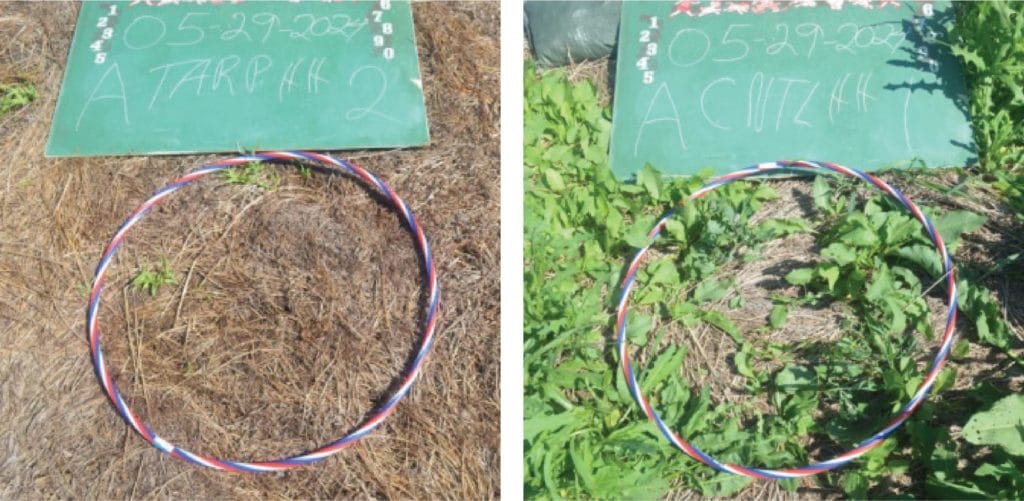
Weed coverage assessment after tarp removal in tarped plots (left) and control/not tarped plots (right) at Marlon Mormann’s. Photos taken May 29, 2024.
Mormann concluded that clear tarps were very effective at preventing weed regrowth but that partial shade, depressions on the ground and air infiltration around the sides of the tarp could prevent adequate heat buildup under the tarp and reduce their effectiveness. He also observed some weed regrowth, largely of grasses, during and after tarping. Interestingly, most of the weeds regrowing in the control/not-tarped plots were forbs.
Overall, Mormann was pleased that the clear tarps worked for weed suppression and plans to continue using them in his garden plots and areas with particular weed issues. In the future, he hopes to use larger research plots and continue studying the effect of tarping timing and moisture content of soil under the tarp on weed suppression.
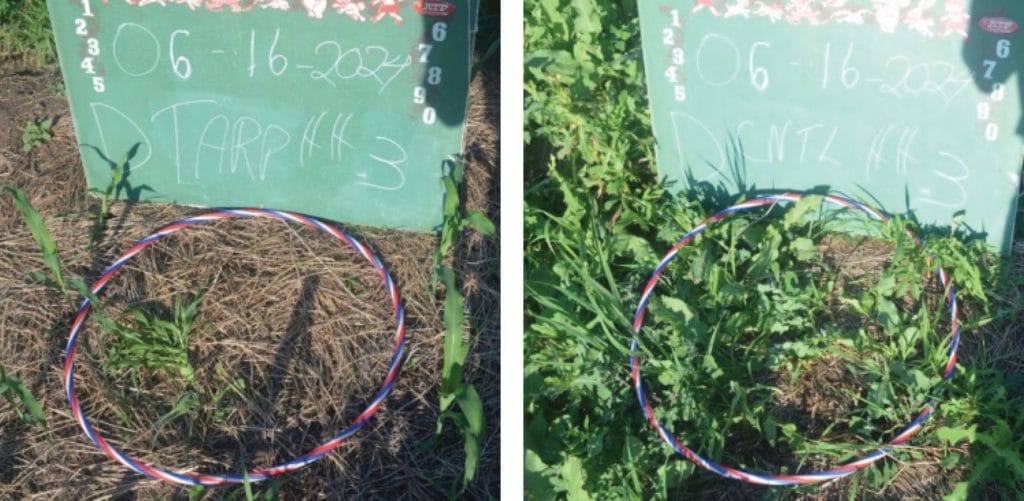
Weed coverage 19 days after tarp removal in tarped plots (left) and control/not tarped plots (right) at Marlon Mormann’s. Mormann noted that many of the weeds regrowing in tarped plots were grasses. Photos taken June 16, 2024.
Conclusions and Next Steps
Tarping with black plastic or clear plastic tarps can be an effective method for creating a weed-free bed for planting, but both Breckbill & Fagan and Mormann note that tarps are not able to stop 100% of weeds. Farmers should expect some regrowth by a week or so after tarp removal, especially in wet and warm conditions. Both farms hope to continue using tarps and would like to study tarping efficacy at different times of year as temperature and sunlight hours vary.
Funding Acknowledgement
This material is based upon work supported by the U.S. Department of Agriculture, under agreement number NR226114XXXXG004. Any opinions, findings, conclusions, or recommendations expressed in this publication are those of the author(s) and do not necessarily reflect the views of the U.S. Department of Agriculture. In addition, any reference to specific brands or types of products or services does not constitute or imply an endorsement by the U.S. Department of Agriculture for those products or services.
Appendix – Trial Design and Weather Conditions

Figure A1. Example of experimental design used by Breckbill & Fagan and Mormann, which included randomized replicated tarping treatments. Number and type of treatment varied between farms as explained in the Methods section. This design allowed for statistical analysis of the results.
References
[1] N. Lounsbury, S. Birthisel, J. Lilley, and R. Maher, “Tarping in the Northeast: A Guide for Small Farms.” University of Maine Cooperative Extension, 2022. Accessed: Jun. 20, 2023. [Online]. Available: https://extension.umaine.edu/publications/1075e/
[2] E. Link, E. Fagan, and H. Breckbill, “Tarping for No-TIll Cover Crop Termination,” Practical Farmers of Iowa, 2023. [Online]. Available: https://practicalfarmers.org/research/tarping-for-no-till-cover-crop-termination/
[3] A. H. Sparks, “nasapower: A NASA POWER Global Meteorology, Surface Solar Energy and Climatology Data Client for R,” J. Open Source Softw., vol. 3, no. 30, p. 1035, Oct. 2018, doi: 10.21105/joss.01035.
[4] S. K. Birthisel and E. R. Gallandt, “Trials Evaluating Solarization and Tarping for Improved Stale Seedbed Preparation in the Northeast USA,” Org. Farming, vol. 5, no. 1, Art. no. 1, Dec. 2019, doi: 10.12924/of2019.05010052.


